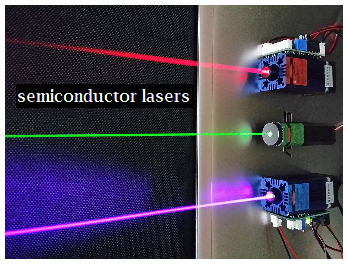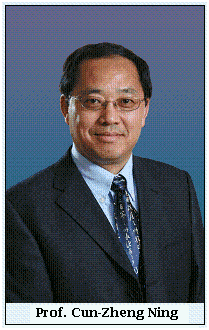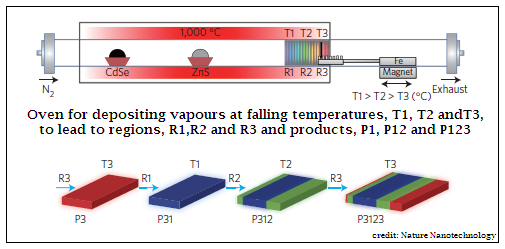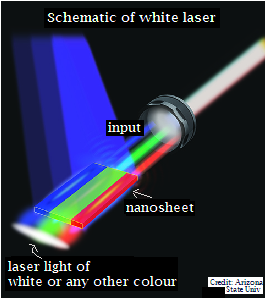A single, one piece semiconductor laser now emits the three primary colours, says S.Ananthanarayanan.
The defining character of the laser is that light waves emerge as a continuous train, not snatches of wave which are not in step with each other. If we took the uniform footfall of a marching soldier as an instance of regular motion, like the rise and fall of a wave, then a laser would be like a platoon marching in step, while ordinary light is like the same soldiers, all marching, but not keeping to the same drumbeat.
Along with this defining character, the hallmark of lasers is that the light arises from energy level transitions within atoms and they shine in light of acutely single colour, or light that has very little spread if it is dispersed by a prism, which splits white light into the whole rainbow. And then, the way laser light is generated makes sure that the rays within a beam are nearly parallel, and the beam does not spread even over great distances.
While the fact that the light waves are all in step, or coherent, has made lasers useful in scientific research, the fact that the beam stays narrow also has many uses. One of these is to generate a very intense beam, that can be used as a welding torch, for instance or as a beam does not dissipate by spread, which could save power for use in communications or to light a signboard at a distance. In this last application of lighting and signage, the capability to create laser light of all colours has important commercial value. A team of researchers in the Arizona State University, including a collaborator from Tsinghua University, Beijing, report in the journal, Nature Nanotechnology, a technique to build a single semiconductor crystal which can produce laser light in each of the primary colours at the same time!
Semiconductors
A common source of light, not necessarily a laser, is the light emitting diode, a device that also uses semiconductor material. The difference between semiconductors and insulators or good conductors is that semiconductors have the capacity to release current carrying charged particles if they are given a small nudge, unlike insulators, which cannot, or conductors, which need hardly any nudge. Now, semiconductors can get even more active if the atoms in a crystal have an impurity of a different kind of atom, which has either one electron, which is the current carrier, more or less that the number that the semiconductor atoms have. In such a case, the material has this extra electron, or the lack of one, called a ‘hole’, which is free to move and conduct electricity.
Things become more interesting when we place these two kinds of semiconductor material, with the wandering electron, or the ‘hole’, against each other. The electrons can cross over to the other side and ‘fill’ the ‘holes’ but there is no way ‘holes’ can cross over to the other side. The junction of the two kinds of semiconductor then becomes a ‘one way gate’, and the device is called a ‘diode’, or a two-terminal device that allows current to pass only in one direction. The electrons that cross over and fill the holes, however, create a negative charge, due to their presence and this prevents more electrons from coming in, and the process stops almost as soon as it starts.
But if a current is passed through the device, so that electrons keep crossing over and neutralising holes, what is happening is that higher energy electrons are falling into lower energy holes, and some of them give off a photon of light, of a colour that corresponds to the energy difference. This is the principle of the Light Emitting Diode, or LED, which is the basis of many display systems, even TV screens. LEDs can now be made to emit light of many colours, including blue, green and red, the ‘primary colours’, and panels of LED lamps can be mixed to create a large number of natural colours.
The laser
The basis of how early gas lasers and also the later solid state lasers work is the property of some atoms which have been excited, either by intense light or by electricity, to pause an instant before they de-excite, by emission of light. Because of this ‘pause’, a good number of atoms can be got excited, so that a chance particle of light could cause a cascade of de-excitation and a flash of laser light. To keep the laser going, the arrangement has a pair of parallel mirrors, which keep photons going back and forth and repeatedly causing laser cascades. In the case of LEDs also, electron-hole pairs can be got to ‘pause’ before they emit that photon of light when they combine. In such a case, again, there can be accumulation of ‘paused’ emitting pairs, waiting to be tripped by a photon of light, and there can be laser action. Crystals of semiconductor material which are arranged for this to happen are called semiconductor lasers and they represent an important segment of lasers, in industry, communications and for lighting and illumination.

As applications of semiconductor lasers grow, there is now interest in creating more and more efficient arrangements to produce different shades of light, and with as compact a device as possible. The paper in Nature Nanotechnology, by Fan Fan, Sunay Turkdogan, Zhicheng Liu, David Shelhammer and Cun-Zheng Ning, Professor of Electrical, Computer and Energy Engineering at ASU, says that apart from being more efficient than LEDs, a panel of four lasers, each emitting light of one colour, can be combined to create almost all the shades present in white light. The best approach to getting to such a combination has been with discrete devices, each emitting in one colour. But having four, or even three, devices for each pixel of a display, for instance, is cumbersome and increases size, complexity and cost.

Early attempts at creating a single device used non-semiconductor material and were bulky, apart from needing a separate interface with the semiconductor material of most other electronic equipment, the authors of the paper say. And building a single semiconductor structure involved growing high quality crystals of dissimilar materials, which has challenges because of the differing lattice geometry.
The more successful efforts in recent times has been with nanocrystals or nanowires of semiconductor material, but even with these, there are issues of the material being opaque to some colours and in creating electrical contacts. Just over two years ago, the present authors had succeeded in creating a composite laser, in the form of a nanosheet and a nanowire with a looped end, made from cadmium, sulphur and selenium which emitted in the green and red. Adding the capacity for blue light was a challenge.
The ideal element to add, for blue light, the authors say, was zinc sulphide (ZnS), which was known to form structures with the other three elements. But ZnS itself had limitations in not being compatible with the geometry favoured by the two-colour emitting nanosheet. The group therefore went into the growth mechanisms of the crystals and was able to coordinate the different stages, so that they arrived at multisegment, mixed structure nanosheets consisting of the four elements in different combinations and with the geometry required for generation of laser light in red, green and blue, simultaneously. The problem of opacity, the authors say, was overcome by a change in the layout of segments, to lie side by side instead of one before the other.

The team has also tested separate optical exciting of each segment, to tune the output, to create different shades and also white light. The description, ’white laser’ the authors say, may sound contradictory, as lasers suggest pure colours and white is a range of colours – but “Our results demonstrate that the apparently contradictory terms ‘white’ and ‘lasing’ can both be realized in a single monolithic structure”, they add.

------------------------------------------------------------------------------------------